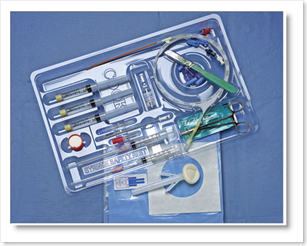As this begins the week of the “Never-Never” rules with Medicare and with Sepsis being included on the hospital acquired  listings, the group is calling for standards to prevent, which includes the use of minocycline and rifampin impregnated catheters. Severe sepsis is common, with over 750,000 cases diagnosed in the United States each year. It is the tenth leading cause of death worldwide, killing approximately one person every minute.
listings, the group is calling for standards to prevent, which includes the use of minocycline and rifampin impregnated catheters. Severe sepsis is common, with over 750,000 cases diagnosed in the United States each year. It is the tenth leading cause of death worldwide, killing approximately one person every minute.
A couple months back I did an interview with Thomas Cherry from Cook Medical interview with Cook Medical that also sheds some light on how the catheters are used.
Also Vanderbilt Medical Center created a Microsoft technology solution to quickly identify Sepsis and you  can read more here, which entails a solution with Server 2008, SQL server and the use of Silverlight to give clinicians a clear and active visual to detect immediately before the condition would progress any further without immediate attention.
can read more here, which entails a solution with Server 2008, SQL server and the use of Silverlight to give clinicians a clear and active visual to detect immediately before the condition would progress any further without immediate attention.
Healthcare jumping out with Server 2008 and all the updated components for the application to track Sepsis, a systemic inflammatory response to infection which can progress to circulatory system dysfunction, multiple organ failure, and eventually death.
Between the use of catheters and technology for immediate detection, hopefully this is a healthcare battle where some real impact can be made and save lives. BD
Press Release
Healthcare Industry Leaders Call for Improved Prevention of Catheter Infections
Recommendations Highlight Prevention Strategies that Will Save Lives and Reduce Healthcare Costs
Washington, D.C. – October 3, 2008 – Today representatives from the roundtable summit, “A Leadership Strategy for the Prevention of Line Sepsis,” released a policy statement outlining strategies for patients and healthcare professionals to reduce the incidence of line sepsis, a potentially fatal hospital-acquired infection that affects approximately 250,000 patients each year in the U.S. alone, according to the Centers for Disease Control and Prevention (CDC). The summit engaged healthcare providers across disciplines, government agencies and constituency groups. The recommendations were announced by representatives from Association for Professionals in Infection Control and Epidemiology, Inc. (APIC), University HealthSystem Consortium and West Penn Allegheny Health System.
The recommendations developed independently by the distinguished panel members call for patients, healthcare associations, government agencies and healthcare professionals to work collaboratively to drastically reduce line infection and include:
- Standardized measurement and implementation of best practices
- Expand patient education to foster greater involvement in their own healthcare
- Cross-disciplinary team development and continuing education on best practices
- Organizational leadership to support a culture of patient safety
- Greater incentives for compliance and data transparency
“Line sepsis is largely considered preventable when adhering to evidence-based guidelines, so it is imperative that patients and hospitals are empowered with information to keep patients safe. The summit’s recommendations are a great contribution to the ongoing, collaborative effort of improving the quality of patient care,” said John Nance, founding board member of the National Patient Safety Foundation and speaker at the summit. “Moreover, the implementation of the Centers for Medicare & Medicaid Services (CMS) reimbursement changes on October 1, 2008, which precludes reimbursement for eight hospital-acquired infections, including line sepsis, further signifies the need for hospitals to reduce the occurrence of infections. This presents both a challenge and an opportunity for American hospitals to adopt best practices in this area and make it mandatory.”
 “The statement from this diverse gathering marks an important milestone in the effort to increase patient safety and quality care,” said David Nash, MD, MBA, Dean, Jefferson School of Health Policy and Population Health and the Dr. Raymond C. and Doris N. Grandon Professor of Health Policy at Thomas Jefferson University in Philadelphia and summit moderator. “With nearly 1.7 million Americans contracting hospital-acquired infections each year, 250,000 of which are line related, hospitals are challenged to deliver a higher quality of care. Only through true collaboration and open educational dialogue can we work towards eliminating these preventable infections.”
“The statement from this diverse gathering marks an important milestone in the effort to increase patient safety and quality care,” said David Nash, MD, MBA, Dean, Jefferson School of Health Policy and Population Health and the Dr. Raymond C. and Doris N. Grandon Professor of Health Policy at Thomas Jefferson University in Philadelphia and summit moderator. “With nearly 1.7 million Americans contracting hospital-acquired infections each year, 250,000 of which are line related, hospitals are challenged to deliver a higher quality of care. Only through true collaboration and open educational dialogue can we work towards eliminating these preventable infections.”
“A Leadership Strategy for the Prevention of Line Sepsis” roundtable summit, supported by an unrestricted educational grant from Cook Medical, a medical device manufacturer that produces minocycline and rifampin impregnated catheters aimed at reducing the occurrence of line sepsis, provided a forum to develop clear recommendations for patients and the healthcare community to follow to prevent line sepsis. Line sepsis develops when bacteria enter a patient’s bloodstream through the channel created by a central venous catheter (CVC). According to research conducted by Johns Hopkins Medical Institution, line sepsis causes approximately 28,000 U.S. deaths each year.
About Thomas Jefferson University:
Thomas Jefferson University, the largest freestanding academic medical center in Philadelphia, is composed of Jefferson Medical College, Jefferson College of Graduate Studies, Jefferson College of Health Professions—which includes the Schools of Pharmacy, Nursing and Health Professions—and Jefferson School of Health Policy and Population Health. Jefferson is regarded nationally as one of the best universities offering a range of comprehensive programs for the education of health professions. The three colleges enroll more than 2,900 future physicians, scientists and health care professionals. Thomas Jefferson University partners with Thomas Jefferson University Hospital, its education and clinical care affiliate. For more information visit www.jefferson.edu.



0 comments :
Post a Comment